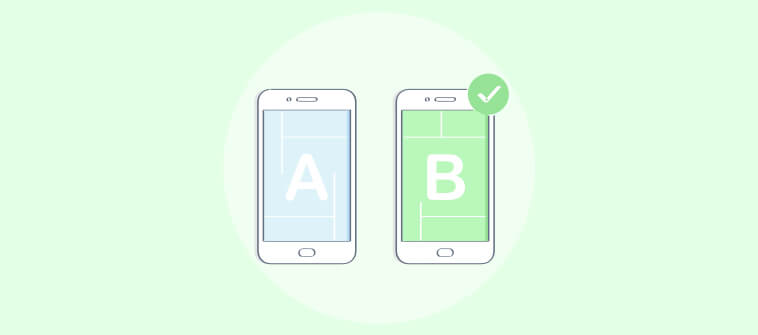
“Don’t you think this CTA would be more appealing if we use a big font in red?” – A marketer to a colleague!
Such conversations in marketing teams are quite common as they are always trying to optimize their campaigns for improved conversions. But, when there is an A/B testing conversion rate optimization technique available, marketers can directly get the answers from website visitors!
Creating multiple variants of something before carrying out your campaigns is a good strategy and that’s where A/B testing comes into the picture. It helps you maximize the effectiveness of marketing efforts made to drive traffic to the website.
Even though A/B testing is one of the most proven and best ways to analyze your conversion funnel and marketing campaigns, many marketers are not doing it successfully. What are they missing? Is it worth it? There are many more questions and we are here to answer!
What is A/B Testing?

A/B testing also referred to as split testing or bucket testing, is simply an experimental process of comparing two versions of website elements like a landing page, exit-popup, sidebar, navigation menu, or any other marketing asset to analyze the difference in performance.
The two versions of the element are shown to different segments of website visitors to assess which version drives the chosen business metrics and produces maximum conversions. Let’s have a look at how exactly A/B testing works.
Let’s say that John created two different exit-popup designs. In the first one, he used a bold font and green color CTA button. In the second, he used an italic font with red color CTA button. The marketing team then displays one popup to one group and the other design to the second group. Then you analyze and see how each of them performs in metrics like clicks, re-directs, email capture, etc.
Now, the red CTA (the second one) delivered better results. The marketing team starts digging into why that is and keeps in mind to follow a similar approach for future campaigns.
Got a clear idea of how A/B conversion testing works? Let’s now move on to check some benefits of AB testing.
Why Do We Really Need A/B Testing?
Creating a website or landing page is one of the initial steps in marketing. Once you are done with the design, you’ll have to figure out the tactics that will help you increase sales and conversions. That’s where A/B testing can help. Here is what A/B testing can do for your business:
- A/B testing helps you improve your sales and lead generation by showing you which version of an asset, such as a CTA button, headline, or form works better.
- It is easy to run, unlike a multivariate test that requires substantial expertise and set-up time.
- Even a failed A/B test gathers important information to help you improve the next iteration.
- A/B testing improves your most important metric: conversions.
A/B testing is one of the most used conversion optimization tactics today. Along with its popularity, the growth of tools that help you perform A/B testing and analyze the results also continues to grow.
Best Elements of A/B Testing
Some elements of A/B testing contribute to conversions more than others. Simply changing a single word in your content copy isn’t going to help you achieve your conversion goals. To give you a heads up when you start your A/B tests, here are some efficient testing elements.
CTA (Call-to-action)
Your call to action (CTA) is where the real action takes place. It decides whether or not your visitors fill the sign-up form, finish their purchases, and take more such actions that have direct links to your conversion rate. This element has different things that you can change like background color, wording, location on the page, size, etc. The variations will help you understand what catches visitors’ attention and has the potential to generate more conversions.
Headlines & Copywriting
Your headline, located at the top of your webpage is the first thing that visitors see. If that doesn’t sound interesting or attract their attention, they won’t stay around. You need to ensure that your headlines and subheadings are catchy, precise, short, and should convey your message delightfully to the visitors. With different fonts and writing styles, you can easily create a few copies to A/B test them and find the best converting one.
Popup/Overlays
Popups are one of the most simple and effective A/B tests that can help you boost your conversion rate significantly. Firstly, you need to display exit popups and overlays without being annoying. You can change the content copy, background image, CTA button, color combination, animation, etc. to find which popup window is keeping the visitors engaged. The generated leads and conversions data are easily available in the popup tool.
Subject Lines
The open rates of marketing emails depend on your subject lines. If the subscriber doesn’t like what they see in that one line when they open the inbox, the email is likely to go to the trash bin. The average open rate across different industries is around 22% and that means only 1 in 4 subscribers see your email content. Getting creative with your subject lines to find what your customers like the most is important. You can try questions versus statements, emojis, power words, etc. to get the best combination.
Images & Videos
49% of marketers rate visual marketing as an important part of their strategies. The audience loves to see short infographics, intuitive videos, and impressive images. From video testimonials to visual storytelling, you can A/B test your graphics to take content marketing to the next level. You can even embed your YouTube videos on specific landing pages and should work on replacing the stock images with something creative and eye-catching.
Content Depth
Based on the industry you are in, content depth is essential. Some visitors want to see each and every detail related to your products or services, while others just skim through the page to see the features in short. So, in which category does your maximum target audience fall? A/B test to get your ideal content depth by creating two pieces (long and short) of the same content. Analyze the results by tracking visitors’ movement to see which piece is more compelling.
Landing Pages
Landing pages are meant for specific audiences to promote/feature particular products or services. A heat map can help you check where visitors are clicking the most on your page. Collect this data to A/B test those elements. From reviews, testimonials to CTAs and product descriptions, consider every element and their layout design for your testing process. Keep your primary focus on the most important elements that will have an impact on your conversions.
Social Proof
Nine out of ten buyers worldwide go through reviews before making a purchase. So, displaying social proofs on your product/landing pages is important for conversions. But, these need to be placed in a creative manner. You can A/B test star ratings vs customer testimonials, static images with quotes vs videos, awards & badges vs certificates, and so on. Test these different types of social proofs by changing their layouts and placements to see what works best for you.
Types of A/B Tests
After learning about the important elements of A/B tests, let’s now learn about the different types of testing methods. We have already discussed the A/B testing above and will now be talking about the others.
Split URL Testing:
People are often confused between A/B testing and split testing. Well, these two are totally different. In split URL testing, a totally new version of the existing web page is designed and analyzed to compare performance. While in A/B testing, slight changes are made at the front-end, marketers make significant changes to the existing page design and content. The incoming traffic is distributed to different URLs to compare the conversion rates and go with the winner.
Multivariate Testing:
Multivariate testing is a complex testing process wherein variations of multiple page elements are tested simultaneously to check the winning combination out of all the possibilities. It is often perfect for advanced marketing tactics and is performed by developers and product specialists. When you ate short on time and resources, changing multiple elements and running concurrent tests can get you results with minimal effort in a short period of time.
Multipage Testing:
An experimentation that helps you test the changes to specific elements across multiple web pages. There are two ways to do so. In Funnel Multipage Testing, you can re-design all the sales funnel pages to create new versions and then test them. In Classic or Conventional Multipage Testing, you can test by adding or removing particular elements like testimonials, badges, images, etc. to check the impact on conversion rate across the website.
For a different and advanced approach, you can try these above-mentioned testing techniques. But for now, let’s shift our focus back on A/B testing
Step-by-Step A/B Testing Guide to Improving Lead Generation & Conversions Rate

A/B testing provides an organized path to find out what works best for your marketing campaign. Although, it should be done through a well-defined process. The A/B conversion rate testing includes the following steps.
Step 1: Choose Variable & Set Goals/Metrics
Before you can A/B test, you need to do research and make decisions. There is no end to elements you can test, but you need to select those with the best payoff and then prioritize which should be tested first. Also, you need to set the parameters of your test, so each version is treated the same.
Once you decide the variable, you need to choose your success metric. Are you after conversions? Shopping cart abandonment? Bounce rate? Sales? You need to weed out as many “gut feelings” and assumptions as you can when deciding the goals and performing your testing. The best way to keep from seeing false results is to define your constants and variable ahead of time to keep your focus on specific things.
Step 2: Select the Page & Elements to A/B Test
You can start with your most important or high-traffic webpage. This can be your homepage or top-performing landing page. Whatever you choose, it should be linked directly to your metrics. After selecting the page, check all the elements like navigation menu, popup window, CTAs, image/videos, reviews, case studies, and so on to see what can be improved.
Make sure that you alter the existing content slightly to see the impact on metrics. Decide the priority of the elements according to what you think will influence conversions the most.
Step 3: Create Variants
Based on your hypothesis above, create a variation to test it against the current version. Change only the elements that you decided in the above step, and make only one change at a time to analyze the results more effectively.
For example, if you are testing your popup window, change the CTA color, font, text, or button size. Next, you can change the input fields or background image. Leave everything else identical to the original popup. You can create multiple variants by changing one element after another in your variable to test it with the control (your original design).
Step 4: Choose your A/B Testing Tools
There is no single A/B testing tool that lets you test all your elements. Depending on what you’re testing, you can find the built-in testing tools in your sales/marketing software. Such tools help you analyze users’ behavior with heatmap and recording/replay to personalize your testing campaigns.
As for exit popups, Picreel offers A/B testing with advanced analytics. Similarly, for email marketing campaigns and landing pages, you can utilize tools like Crazy Egg and AB Tasty to track visitors’ movement and conversion data.
Step 5: Run That Test
According to the tool that you’ll be using, you might see different options for collecting data like specific devices, location, and other details. You need to specify the time here for how long you want to run the test. According to your average website traffic, you can decide the timing and duration of the test.
This helps in monitoring the metric like improvement in conversion rate with comparison to the control when tested against the same percentage of traffic. You will get more accurate results only if you configure these options right.
Step 6: Analyze A/B Testing Results/Statistics & Deploy
Get to conclusions based on the results you get. The analysis is not only important for finding the winner, but also for gathering data about different elements you A/B test. Consider all the metrics like increase in conversion rate, decrease in bounce rate, increase in revenue, etc. If the test succeeds and you have got your winner(A or B), deploy that variation.
Here, you might find the results inconclusive or a failed test where you get similar conversions as before. It’s not concerning and happens a lot. Draw insights from it and implement it in future A/B tests to boost conversions.
Once you are done with these six simple steps, repeat the same again when you start with a different variant.
Bonus Tips for Setting Up A/B Testing
A/B testing is not difficult, but there are a few things you can do to improve your results.
Tip #1: Work to Achieve Relevance
A/B testing may uncover how relevant your campaign is to your target audience. You already know your content must be relevant to generate traffic, but maybe you will find a variation that outperforms your control because it presents the information in a more relevant form.
Tip #2: Build a Repeatable Process
For the best results, you need to have an A/B testing process that treats each pair of controls and variables the same way. You can’t control the internet environment, but you can keep variability out of your testing protocols.
The process should cover every variable aspect of your marketing asset including the headline, position of the pictures, and color of the CTA button. Everything on the page that can be reasonably changed is ripe for testing. However, only change one variable at a time; otherwise, you won’t know which change made the impact.
Tip #3: Make Sure Your Objective Is Clear
CXL uses an acronym to evaluate the objectives. They say an objective should be DUMB (Doable, Understandable, Manageable, and Beneficial). We would add that your objective should be measurable, otherwise how will you know you have reached it?
So, work upon these while deciding your variable and goals. You will know what to do and how to analyze if you make the objective crystal clear at the beginning.
Mistakes to Avoid While Testing
A/B testing is one of the most effective ways to improve your conversion rates. When you monitor your analytics, you are measuring how a particular page is performing in terms of visitors, clicks, bounce rates, and conversions. However, this task demands patience and planning. Running quickly for results can lead to silly mistakes. Here are some common ones:
Mistake #1: Poor Roadmap Planning
The hypothesis is important before actually running the test. Your next steps will depend on it like what element should be changed, what are the expected results, why should an element be prioritized, and so on. Getting off with wring hypothesis results in failure of tests.
Also, never follow others’ tactics blindly. If someone’s conversions got up by 40% using a multi-step signup form, that doesn’t mean you would achieve the same results. Goals and strategies are different for different audiences and businesses. What worked for them might not work for you. So, optimize your conversions by looking at your audience and b2b website design.
Mistake #2: Testing Multiple Elements Together
A/B testing includes running a single test at one time. Going for testing multiple elements at the same time can lead to confusion, making it difficult to identify which element proved to be successful or which one leads to failure.
Also, for testing more elements, you will need to have more traffic on the webpage for detailed analytics. Thus, you should simply prepare a priority list for the elements to avoid this mess and achieve successful A/B testing campaigns.
Mistake #3: Testing for Incorrect Time Duration
As per your average traffic and goals, you need to run your AB testing and conversion rate optimization campaigns for a certain period of time. In search of quick results, marketers often run short campaigns and that produces inaccurate results.
Similarly, letting a campaign run for a very long time can also give insignificant results and that’s a common blunder that businesses commit. Why so? Because the tests depend on different factors like existing traffic, new traffic, ongoing marketing campaigns on other platforms, and so on. So, you need to decide on an average duration by considering these factors.
Mistake #4: Using Unbalanced Traffic
Testing both variants (A & B) using unbalanced traffic will end up generating inconclusive results. Both lower and higher traffic is not good for the testing process. You need to be accurate in dividing the website traffic to get the best results.
Also, make sure to use equal traffic for both your variants and the visitors should be divided in a way where both existing and new traffic gets to see the different variants. It is important in cases where your metric is conversion rate.
Mistake #5: Giving up on the Iterative Process
A/B testing is an iterative process and marketers should not stop after just one test. Even if the test fails, you will have the insightful data at your disposal to make changes in the right direction. The success probability will keep on increasing when you deploy your next tests.
In case of success in your first test, go with all the elements you specified in your priority list in upcoming tests. This will help you in producing the most optimized version of your variables like landing pages and popups.
So, A or B? Find it out!
You do not have anything to show you that a particular page could perform better until you test a change that you hope will make it work better. If you never experiment, you will never know that if you put an image of a person on your page, your conversion rate would jump 60%. Or that a CTA button that says something other than Submit or Click Here would improve conversions. With the help of this comprehensive guide, you now know what to do.
Make sure to choose the right sales and marketing tools that have advanced A/B testing features with detailed reporting & analytics. Now that you know all about the AB testing conversion rate optimization techniques, it’s time to get started!
Do you want instant 300% growth?
Picreel popups can get YOUR website 300% instant sales growth. See Case Studies.






